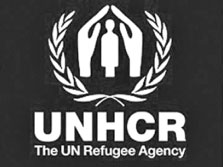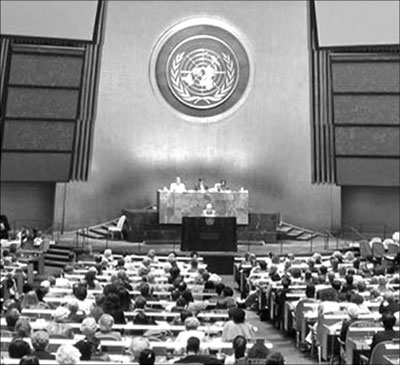|
Geneva endorses Sri Lankan success:
Laying to rest the ghost of IDP horror
 The
recent closure of Menik Farm, the main IDP village, signaled a major
success in Sri Lanka’s handling of the most pressing post-conflict
issue. It has given the lie to all those sceptics and peddlers of
misinformation about the actual treatment of the IDPs from the time the
armed conflict came to an end in May 2009. With the beginning of the
influx of IDPs fleeing the LTTE that was holding them as human shields
in Nandikadal in Mullaitivu, Sri Lanka became the target of continued
attacks on their alleged ill-treatment, with little if any consideration
for the enormous task the country was faced with. The
recent closure of Menik Farm, the main IDP village, signaled a major
success in Sri Lanka’s handling of the most pressing post-conflict
issue. It has given the lie to all those sceptics and peddlers of
misinformation about the actual treatment of the IDPs from the time the
armed conflict came to an end in May 2009. With the beginning of the
influx of IDPs fleeing the LTTE that was holding them as human shields
in Nandikadal in Mullaitivu, Sri Lanka became the target of continued
attacks on their alleged ill-treatment, with little if any consideration
for the enormous task the country was faced with.

Although several foreign countries came in to assist, and
international organizations including UN agencies, and several local
organizations of civil society and charities also joined in the relief
measures, the howls of strident and ill-informed criticism, amounting to
a blare of abuse, continued, with little regard to what was actually
taking place.
Menik Farm and other IDP centres were described by many Western
media, human rights organizations and the thinly veiled agents of the
LTTE abroad, as detention camps, some claiming they were as bad as the
concentration camps of Nazi Germany, and the later horrors of
Srebrenica.
People photographed behind barbed wire fences, which were a necessity
to keep them safe from attack from outside, and for purposes of
enumeration, were described as inmates of the most cruel places of
detention yearning to come out; despite the clear evidence of the
efforts being made to provide them with every facility - from shelter to
health and education, and later travel outside, too - despite the severe
constraints on the state.
Welfare centres
|

Ambassador
Ravinatha Ariyasinha |
One easily recalls the many alarms sent out by foreign 'do-gooders'
who had a different agenda than that of helping the IDPs. There were
frequent and baseless warnings of outbreaks of epidemics inside the
welfare centres and dire warnings of imminent flooding in the shelters.
Neither took place, confirming the official position and the view of
those actually involved in relief work that there were no such dangers.
The use of tents provided by the UN to shelter of the IDPS, with the
discomfort within, much against the wishes of Sri Lankan authorities who
knew better of local conditions and material for shelter, was shown as
disregard for the comfort of the displaced people.
There was little said about the arrangements being made from the
outset to reintegrate into society these nearly 300,000 people, who had
suffered most under the LTTE, in its final days of battle for the
success of terror, after their lives were shattered when they were
forced to follow the LTTE in its march to battle the Sri Lankan Armed
Forces, and finally turned into the human shields to protect the same
brutal leadership of terror. At one stage Amnesty International launched
an international 'Unlock the Gates' campaign, to 'free' these Tamil
people held in what it described as brutal conditions of incarceration.
All of this misrepresentation, mainly to serve the interests of the
LTTE, and its well funded political agents in the West, did not produce
the results expected. Sri Lanka carried out its responsibilities with
the welfare of the IDPs given the highest priority, and now we have come
to the end of the IDP phase within the country.
UNHCR
This was emphasized by Ambassador Ravinatha Ariyasinha, in his
address to the 63rd Session of the Executive Committee of the United
Nations High Commissioner for Refugees (UNHCR) on Tuesday, when he said
that, "in contrast to the considerable difficulty and gloom in the
humanitarian crises that continue to engulf many parts of the world
today, Sri Lanka’s recent achievements provide confidence and hope."
Sri Lanka's Permanent representative to the UN in Geneva added:
“Those who downplay the significance of Sri Lanka's post-conflict
achievements and constantly keep shifting goal posts, show disrespect
not only to Sri Lanka and its international partners whose steadfast
commitment to this task has made these achievements possible, but also
to those who have at last emerged from the suffering caused by 30 years
of terrorist conflict.”
Detailing the considerable progress made in a little over three years
- in IDP resettlement, demining, re-integration of ex-LTTE combatants,
the shrinking of the high security zones, increase of economic growth in
the Northern province and operationalization of LLRC recommendations,
ambassador Ariyasinha said, "it lends credence to the position that even
the most severe and insurmountable of challenges could be overcome with
the political commitment and dedication of the concerned country, and
the requisite support provided by the international community.”
He recalled, as many others would, how in May 2009, as the terrorist
conflict in Sri Lanka came to an end and the caring of nearly 300,000
IDPs became necessary, much fear was expressed in some quarters that
malnutrition, disease and death would be rampant in the IDP villages;
that the government would not be interested in demining; that IDPs would
be 'incarcerated' indefinitely. The government’s intent regards the ex-LTTE
combatants was questioned with the claim that “they would not be
released and that their lives would be in danger”.
|

United Nations High Commissioner for Refugees (UNHCR)
proceeding. File photo |
It was also said that the high security zones would not be disbanded;
that the government would not be able to undertake the massive
investment that was needed to restore livelihoods and ensure
infrastructure development in the previously conflict-affected areas,
and that no effort will be made towards post-conflict reconciliation.”
All these fears, which made headlines as an essential part of the
anti-Sri Lanka media chorus for more than a year, and were repeated by
rights groups that had little actual interest in the welfare of the
displaced Tamils, but were having their own game plan of attack on Sri
Lanka, have now been proved untrue, and convincingly so.
The hard facts
The facts as presented to the UNHCR were the most effectively
detailed and verifiable, exposing the canards that were presented to the
world for so long about the IDP situation in this country.
• The socio-economic, nutritional and mortality indicators in Sri
Lanka's IDP villages which at its peak 295,873 IDPs were deemed
commendable by international standards, to that of a normal population
of this magnitude. Access to education, health and recreational
facilities were provided to children living in the welfare villages.
• With the resettlement of IDPs displaced at the end of the conflict
over three years ago, the final IDP village ‘Menik Farm’ was closed down
last week, and Sri Lanka remains committed to addressing the remaining
challenges of the returnees, including some who still live with host
families. The UN Resident Coordinator Subinay Nandy, has noted that 'The
closure of the camp is a significant sign of the transition from
conflict to sustainable peace and the commitment of the government to
resettling tens of thousands of people back to their homes’.
• The resettlement process has gone hand in hand with the demining
and demilitarization of the former conflict-affected areas. Of the
estimated 2,061.53 sq.km. contaminated with landmines and UXOs, less
than 116 sq.km. remain to be cleared. It is noteworthy that 75 percent
of the demining work has been carried out by the Sri Lanka Army.
• The former high security zones have ceased to exist, and the
Security Forces presence in the Jaffna peninsula has been reduced from
50,000 at the height of the conflict, to 15,000 at present, and the
military is no longer involved in civil administration in the Northern
and Eastern provinces.
• Of the approximately 12,000 ex-LTTE combatants who surrendered or
were arrested at the end of the conflict, 10,981 (which included 594
child combatants), have been rehabilitated and re-integrated with their
families and society.
• With extensive government investment in infrastructure and
livelihood development, the former conflict-affected Northern Province
which recorded a growth rate of 22 percent in 2010 continued the trend
recording a 27.1 percent growth rate in 2011, which was by far the
highest growth rate among all provinces. The Northern province has
continued to increase its share of the national economy driven by an
expansion in agriculture, fishing, construction, transportation and
financial serves.
• Following the submission of the report of Sri Lanka’s domestic
reconciliation mechanism - the Lessons Learnt and Reconciliation
Commission (LLRC) in November 2011, the government of Sri Lanka in July
2012 released its strategy for the implementation of the
recommendations, under the direction of an eight-member Task Force
headed by the Secretary to the President. ‘Land return and resettlement’
comprises, inter alia, an important sub-theme in this Action Plan, with
resettlement already at an advanced stage of implementation.
High Commissioner
The best proof of Sri Lanka’s success in dealing with one of the
biggest IDP situations in recent times came from the UN High
Commissioner for refugees Antonio Guterres who observed that "the
operational role of the UNHCR in Sri Lanka will be phased down for many
of the reasons that were elaborated upon in the ambassador's statement".
He added that "UNHCR will continue to be committed to supporting
voluntary repatriation of some of the refugees of Sri Lanka from India,
as well as with the resettlement of the remainder of the internally
displaced in their places of origin."
This observation by the UN High Commissioner for Refugees should
hopefully help open the eyes of those in Tamil Nadu, especially Chief
Minister Jayalalithaa and her rival Karunanidhi, as well as the
virulently pro-LTTE hangers on such as Vaiko, who not only support Eelam,
but keep shedding crocodile tears for the Sri Lankan Tamils, with
massively pretended concern for the Tamil IDPs in the North. The UNHCR’s
assessment of how we have handled the IDP issue, should also help
Manmohan Singh to be more firm with the pro-Eelamists who are trying to
use the Sri Lankan Tamil issue to rock the boat in New Delhi in the play
for great power to the Tamil Nadu region.
Ambassador Ariyasinha struck the correct concluding note when he told
the UNHRC that, “Sri Lanka remains ready to share its experience and
best practices in post-conflict resettlement and rehabilitation with the
international community. We also look forward to strengthening the
ongoing cooperation between the UNHCR and member states.” |





